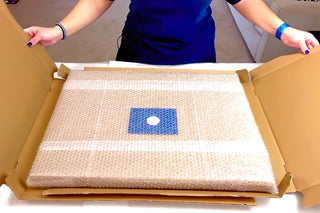Natural History Set No. 4, 4 Mixing Sheets - Anselmus Botius de Boodt | Art print


View from behind

Frame (optional)
A refined naturalist composition: Natural History Collection No. 4, 4 Mixing Sheets by Anselmus Botius de Boodt
The art print of Natural History Collection No. 4, 4 Mixing Sheets reveals a subtle harmony between botanical plates and scientific study motifs, where sepia, green, and ochre tones intertwine precisely. The framing highlights the delicacy of the venation and the velvety texture of the leaves, while the drawing and aquatint techniques faithfully reproduce the grain and nuances. The overall atmosphere is both erudite and poetic, inviting contemplation of naturalistic details without losing compositional balance. This piece captures the harmony between scientific rigor and aesthetic sensitivity.
Anselmus Botius de Boodt, master of the Baroque curiosity cabinet
Anselmus Botius de Boodt, a 17th-century figure, is recognized for his work in intellectual goldsmithing and his contributions to mineralogy and herbalism. Working at the crossroads of natural sciences and graphic arts, he influenced how curiosity cabinets documented specimens with precise and ornate plates. His work is rooted in the learned Baroque tradition, where meticulous observation is paired with careful representation, close to the naturalist engravings of the period. This art print bears witness to his role in disseminating knowledge and the scientific aesthetics characteristic of 17th-century scholars.
A decorative acquisition with multiple assets
This art print of Natural History Collection No. 4, 4 Mixing Sheets fits perfectly in a living room, office, or library, adding an erudite and vintage touch. The art print Natural History Collection No. 4, 4 Mixing Sheets also works well as a pendant or as a single piece above a console or shelf, and its neutral palette makes it easy to match with various interior styles. Offered in high fidelity, the canvas Natural History Collection No. 4, 4 Mixing Sheets preserves the original details and texture for a faithful and durable reproduction. Choosing this piece means opting for a decoration that combines historical authenticity with refined aesthetics.

Matte finish

View from behind

Frame (optional)
A refined naturalist composition: Natural History Collection No. 4, 4 Mixing Sheets by Anselmus Botius de Boodt
The art print of Natural History Collection No. 4, 4 Mixing Sheets reveals a subtle harmony between botanical plates and scientific study motifs, where sepia, green, and ochre tones intertwine precisely. The framing highlights the delicacy of the venation and the velvety texture of the leaves, while the drawing and aquatint techniques faithfully reproduce the grain and nuances. The overall atmosphere is both erudite and poetic, inviting contemplation of naturalistic details without losing compositional balance. This piece captures the harmony between scientific rigor and aesthetic sensitivity.
Anselmus Botius de Boodt, master of the Baroque curiosity cabinet
Anselmus Botius de Boodt, a 17th-century figure, is recognized for his work in intellectual goldsmithing and his contributions to mineralogy and herbalism. Working at the crossroads of natural sciences and graphic arts, he influenced how curiosity cabinets documented specimens with precise and ornate plates. His work is rooted in the learned Baroque tradition, where meticulous observation is paired with careful representation, close to the naturalist engravings of the period. This art print bears witness to his role in disseminating knowledge and the scientific aesthetics characteristic of 17th-century scholars.
A decorative acquisition with multiple assets
This art print of Natural History Collection No. 4, 4 Mixing Sheets fits perfectly in a living room, office, or library, adding an erudite and vintage touch. The art print Natural History Collection No. 4, 4 Mixing Sheets also works well as a pendant or as a single piece above a console or shelf, and its neutral palette makes it easy to match with various interior styles. Offered in high fidelity, the canvas Natural History Collection No. 4, 4 Mixing Sheets preserves the original details and texture for a faithful and durable reproduction. Choosing this piece means opting for a decoration that combines historical authenticity with refined aesthetics.






